计算机专业英语 Chapter4
unit4 计算机专业英语
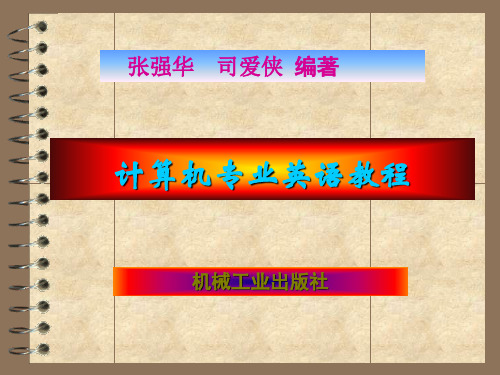
Notes
[5]Routing tables are the means by which a router selects the fastest or nearest path to the next “hop” on the way to a data packet’s final destination. 本句中, by which a router selects the fastest or nearest path to the next “hop” on the way to a data packet’s final destination 是一个介词前置的定语从句,修饰和限定the means。on the way to“在……途中”。
学生课下活动设计
阅读Unit4的Reading。完成作业
作业: 我的梦想是成为一家电脑公司的销售经理。 老师告诉同学们别触摸电脑屏幕。 他停下来喝了杯茶。 他努力学习为了通过期末考试。 学校是孩子们学习的好地方。 这些学生经常帮助老师打扫实验室。 昨天我忘了邮信了。 他足够大了可以自己做决定。
教学参考资料推荐
Notes
[3] The MAU does actively regenerate signals as it transmits data around the ring. 本句中,does起强调作用。 [4]Routers contain internal tables of information called routing tables that keep track of all known network addresses and possible paths throughout the internetwork,along with cost of reaching each network. 本句中,called routing tables是过去分词短语,做定语,修饰 和限定internal tables of information。that keep track of all known network addresses and possible paths throughout the internetwork,along with cost of reaching each network是一 个定语从句,修饰和限定routing tables。keep track of是“ 跟踪”。
计算机专业英语Unit 4 Programming Language

Computer English
New words and useful expressions
generation /dʒenə'reiʃn / syntax / 'sintæ ks / primitive / 'prɪmɪtɪv / symbolic / sɪm'bɑlɪk / neural / 'njurəl / imitate / 'ɪmɪteɪt / switch/ swɪtʃ / instruction/ ɪn'strʌkʃn /
Contents
Logo
1 Five Generation of Languages 2 Programming Languages Level 3 Programming Paradigms 4 Procedural Oriented Programming
5 Object Oriented Programming
❖Typically used to access databases. For example, SQL and ColdFusion.
Logo
Fifth generation languages (5GL)
❖Designed to make the computer solve a given problem without the programmer.
Logo
Fourth generation languages (4GL)
❖The syntax used in 4GL is very close to human language, an improvement from the previous generation of languages.
计算机专业英语Unit04-Programming and Simulation

Computer Program-Program Development At this point, a special applications program translates the source code into machine language, or object code —a format that the operating system will recognize as a proper program and be able to execute.
I. 引言 计算机程序是指挥计算机执行某种处理功能或功能 组合的一套指令。要使指令得到执行,计算机必须执行程序, 也就是说,计算机要读取程序,然后按准确的顺序实施程序中 编码的步骤,直至程序结束.
2/56
Computer Program-Introduction
A program can be executed many different times, with each execution yielding a potentially different result depending upon the options and data that the user gives the computer.Yield: vt. 生产,释放,让步
编译程序将使用FORTRAN、C和Pascal等高级编程语言编写的 文本文件一次性从源代码翻译成目标代码。这不同于BASIC等 解释执行的语言所采取的方式,在解释执行的语言中程序是随 着每条指令的执行而逐个语句地翻译成目标代码的。
10/56
Computer Program-Program Development
在这个时候,一种专门的应用程序将源代码翻译成机器 语言或目标代码——操作系统将认作真正程序并能够执 行的一种格式。
计算机专业英语 Chapter4

3
4.1 Stacks and queues
New Words & Expressions:
stack n. 栈,堆栈 attribute n. 属性,性质 overflow n. 上溢
栈和队列都是动态的集合,其中的元素由预先定义的删除操作可将其去 除。在栈中,最近被插入的元素最先被删除,即栈是按后进先出(LIFO) 的原则进行的;类似的,在队列里,被删除的元素是最早进入队列的, 即队列是以先进先出(FIFO)的原则进行的。在计算机上,对于栈和队列 有几种有效的实现方法,这一节我们给出如何用简单的数组来实现它们。
6
4.1 Stacks and queues
4.1.2 Queues
We call the INSERT operation on a queue ENQUEUE, and we call the DELETE operation DEQUEUE; like the stack operation POP, DEQUEUE takes no element argument. The FIFO property of a queue causes it to operate like a line of people in the registrar's office. The queue has a head and a tail. When an element is enqueued, it takes its place at the tail of the queue, just as a newly arriving student takes a place at the end of the line. The element dequeued is always the one at the head of the queue, like the student at the head of the line who has waited the longest. (Fortunately, we don't have to worry about computational elements cutting into line.)
计算机专业英语(课后题)

计算机专业英语(课后题)第四章课后习题Circle the correct answer:1.These specialized graphics programs combine text and graphics to create publications of professional quality:A.desktop publishing programs c.image galleriesB.image editors d.illustration programs2.Also known as drawing programs.a.desktop publishing programs c.image galleriesb.image editors d.illustrarion programs3.Graphics programs used to ctreate and edit vector images.a.desktop publishing programs c.image galleriesb.image editors d.illustrarion programs4.An essential multimedia feature that allowa user participationa.Flash c.immersionb.interactivity d.raster5.Special programs used to create multimedia presentations.a.desktop publishing programs c.immersionb.interactivity d.multimedia authoring programs6.A widly used interactive animation application from Adobe.a.ACTION c.Fuzzyb.Flash d.WYSIWYG7.Programs for Web site design and HTML coding are called Web page editors ora.apps c.VR programsb.HTML editors d.Web editors8.This area of artificial intelligence is also known as expert systems.a.acoustics c.roboticsb.knowledge-bassed systems. D.virtual reality9.A type of artificial intelligence that uses a database to provide assistance to users.a.acoustics c.roboticsb.expert systems d.virtual reality10.Another name for the database used in expert sysrems that contains specific facts and rules.a.access table c.knowledge baseb.expert table d.rule baseMatch each numbered item with the most closely related lettered item.Write your answers in the spaces provided.a.audio editing e 1.Specialized graphics programs for editing or modifying digital imagesb.bitmap images b 2.Another name for raster images.c.blog g 3.Raster images contain thousands of dots known as .d.button a 4.Type of software used to create and edit audio clips.e.image editors d 5.A link on amultimedia page used to locate and discover information.f.mobile c 6.Personal Web site created by an individualg.pixels j 7.The process of creating a Web site.h.virtual reality h 8.Also known as artificial reality or virtual environments.I.robots i /doc/ed1120702.html,puter-controlled machines that mimichuman activitiesj.Web authoring f 10.The type of app designed for smartphones,netbooks,and tablets.Circle the correct answer:1.What type of software works with users,applicationsoftware,and computer hardware to handle the majority of technical details?a.application c.Linuxb.desktop d.system2.The programs that convert programming instructions written by programmers into a language that computers understand and process are language:a.converters c.managersb.linguists d.translators3.The ability to switch between different applications stored in memory is called :a.diversion c.operational interferenceb.multitasking d.programming4.Graphic representations for a program,type of file,or function:a.app c.imageb.icon d.software5.This operating system feature is controlled by a mouse and changes shape depending on its current functiona.dialog box c.mouseb.menu d.pointer6.The operating system based on Linux,designed for Netbook computers,and focused on Inernet connectivity through cloud computing:a.Chrome c. UNIXb.Mac d.Windows7.The mobile operating system develop by Apple and originally called iPhone OS :a.Android c.IOSb.BlackBerry OS d.Mac OS8.A utility program that makes copies of files to be used in case the originals are lost or damaged:a.Backup and Restore c.Disk Defragmenterb.Disk Cleanup /doc/ed1120702.html,pactor9.A troubleshooting utility that identifiles and eliminates nonessential files,frees up valuable disk space ,and improves system performance:a.Backup and Restore c.Disk Defragmenterb.Disk Cleanup /doc/ed1120702.html,pactor10.Windows makes it easy to update drivers with Windows:a.Backup c.Driverb.Restore d. UpdateMatch each numbered item with the most closely related lettered item. Write your answers in the spaces provided.a.antivirus h 1.Programs that perform specific tasks related to managing computer resourcesb.Boot Camp j 2.Restarting a running computer without turning off the powerc.driver e 3.Type of operating system that controls and coordinates networked computers.d.fragmented f 4.An operating system is often referred to as the software environment ore.NOS b 5.Allows Macintosh computers toren both Mac OS and the Windows operating system.f.platform i 6.A type of software that allows a single physical computer to operate as though it were two or more separate and independent computers.g.Anddroid g 7.Mobile operating system that is owned byGoogle and is one of the fastest-growing mobile operating systems.h.utilities a 8.Type of program that guards computer systems fromviruses and other damaging programs.I. virtualization d 9.If a file cannot be saved on a single track ,it has to bej.warm boot c 10.Program that works with the operating system to allow communication between a device and the rest of a computer system is called a device第六章选择题1. this container houses most of the electrical components for a computer system.a. carrier package c. system unitb. system board d. TV tuner2. similar to notebooks, this system unit specializes in on-the-go Web browsing and e-mail access.a. chassis c. media centerb. desktop d. netbook3. computers can only recognize this type of electronic signal.a. analog c. digitalb. bus d. maximum4. the main or motherboard is also known as the:a. computer c. mobile systemb. board processor d. system board5. how many bytes can a 32-bit-wrd computer access at a time?a. 1 c. 8b. 4 d. 166. in a microcomputer system , the central processing unit iscontained on a single:a. bus c. moduleb. chip d. RAM7. this type of memory divides large programs into parts and stores the parts on a secondary storage device.a. direct c. random-accessb. expanded d. virtual8. also known as NIC, this adapter card is used to connect a computer to a :a. AIA c. graphicsb. expansion d. network9. this provides a pathway to connect parts of the CPU to each other:a. bus c. wiredb. Plug and Play d. wireless10. older ports that have largely been replaced by faster, more flexible ports are called:a. buses c. legacyb. expandable d. rednered匹配题1. The category of system units that blurs the line between desktop computers and dedicated entertainment devices. Media center2. The newer type of tablet PC that is almost all monitor. slate3. System board component that provides a connection point for specialized cards or circuit boards. slots4. Plastic cards the size of a regular credit card that have an embedded specialty chip. Smart cards5. A type of memory that improves processing by acting as a temporary high-speed holding area between the memory andthe CPU. cache6. A type of memory that provides a combination of features of RAM and ROM. Flash7. A generic term that is associated with the ability to attach any device onto a computer and have it play or work immediately. Plug and Play8. This bus connects the CPU to memory on the system board. system9. This port can be used to connect many USB devices to the system. USB10. This unit plugs into s standard wall outlet and converts AC to DC. Power supply第七章选择题1. Most keyboards use an arrangement of keys known as:a. Alpha c. OptiKeyb. Daisy d. QWERTY2. The device that controls a pointer displayed on the monitor.a. cord c. printerb. mouse d. scanner3. Also known as a roller ball, this device controls the pointer by rotating a ball with your thumb.a. trackball c. cordless mouseb. joystick d. stylus4. The type of screen that can be touched with more than one finger and supports zooming in and out by pinching and stretching your fingers.a. digital c. multitouchb. dynamic d. OLED5. Flatbed and document are types of:a. headsets c. monitorsb. HDTVs d. scanners6. Device used by banks to automatically read those unusual numbers on the bottom of checks and deposit slips.a. MICR c. OMRb. FDIC d. UPC7. The most widely used audio-input device.a. mouse c. microphoneb. VR d. TFT8. The monitor feature that specifies how often a displayed image is updated.a. aspect ratio c. refresh rateb. dot pitch d. resolution rate9. Handheld, book-sized devices that display text and graphicsa. e-book-readers c. lasersb. HDTV d. whiteboards10. This technology allows television stations to broadcast their programming directly to smartphones, computers, and digital media players.a. CRT c. LEDb. HDTV d. Mobile DTV匹配题1. Pressing this key turns this feature on or off. Caps lock2. This type of mouse has a ball on the bottom and is attached with a cord to the system unit. Mechanical3. A penlike device commonly use with tablet PCs and PDAs. stylus4. Bar code readers use either handheld wand readers orplatform. scanners5. Bar code system used by many electronic cash registers. UPC6. Records images digitally on a disk or in its memory. Digital camera7. The distance between each pixel. Dot pitch8. A type of monitor that activates each pixel independently. Active-matrix9. Special-purpose printers for creating maps, images, and architectural and engineering drawings. plotters10. A type of Internet telephone service that requires a small adapter that connects directly to your computer’s USB port. MagicJack。
计算机专业英语unit 4-2

Thank You!
Exercises
Find Information Task Ⅰ: 1. Broadband is the name given to any fast, permanent Internet connection. 2. It can be delivered by cable, satellite, mobile phone and ADSL. 3. Your ISP will test and activate the line for you. 4. Yes, they are. 5. Mobile is the newest form of the broadband.
Some cable TV companies offer a cable internet connection via their existing wiring.
Passage-learning
Fibre-optics are tiny wires that transmit pulses of light. Since light is the fastest thing in the universe, they're much faster than ADSL cables. This means you can get internet speeds up to five times faster than the fastest ADSL connections.
Unit four Computer network (2)
Contents
1. Lead-in activity 2. Passage learning
3. Exercises 4. Fun time
Unit 4-计算机专业英语(第2版)-邱晓红-清华大学出版社
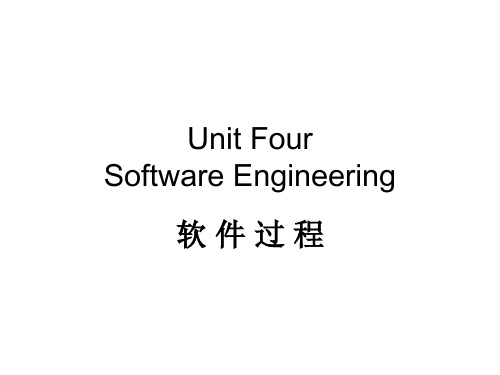
Unit Four Software Engineering 软件过程Text A Software processes软件过程A software process is a set of activities that leads to the production of a software product.一个软件过程是一组引发软件产品生产的活动。
These activities may involve the development of software from scratch in a standard programming language like Java or C.这些活动刻画了软件使用像Java或C这样的标准编程语言从头开始的一步步的开发过程。
Increasingly, however,new software is developed by extending and modifying existing systems and by configuring and integrating off-the-shelf software or system components.然而,现在越来越多的软件是通过在旧软件基础上修改或通过配置和集成现成软件或系统组件而形成。
Software processes are complex and, like all intellectual and creative processes, rely on people making decisions and judgements.软件过程是复杂的,像所有智力过程一样,它依赖于人的判断。
Because of the need for judgement and creativity, attempts to automate software processes have met with limited success.因而需要判断和创造力,软件过程自动化的尝试只获得了有限的成功。
新编计算机英语教程chapter 04

Section B Secondary Storage
• • 1. What is secondary storage? Secondary storage, or storage in popular usage, differs from primary storage in that it is not directly accessible by the CPU. Secondary storage does not loose the data when device is powered down—it is nonvolatile.
2. Primary storage devices
• RAM There are several types of RAM: DRAM, SDRAM, DDR SDRAM, etc.. • ROM Read-only memory (usually known by its acronym, ROM) is a class of storage media used in computers and other electronic devices. Because data stored in ROM cannot be modified (at least not very quickly or easily), it is mainly used to distribute firmware (software that is very closely tied to specific hardware, and unlikely to require frequent updates).
Section A. Primary Storage
1. What is primary storage?
计算机专业英语第4章

03
Hard disks and SSDs are internal storage devices that are installed inside the computer case, while optical disks and removable storage media are external storage devices that can be inserted into the computer
03
Data storage and processing
Data type
Primitive Data Types
These are the basic data types that are built into the programming language They include integer, floating point, character, boolean, etc
Computer Professional English Chapter 4
目录
• Fundamentals of Computer Hardware • Fundamentals of Computer Software • Data storage and processing • Network and Communication
03
Storage Devices
These are physical devices that are used for data storage They include hard drives, SSDs (Solid State Drivers), CD-ROM, USB drives, etc
计算机专业英语(2008影印版)课后习题答案(包括crossword_puzzle的句子翻译)

Computing Essentials 2008课后练习题答案详解Chapter 1: Information Technology, The Internet, and Y ouCrossword Puzzle Answers: (p22)Across1 、The most essential part of an information system. People信息系统最基本的部分。
人7 、Coordinates computer resources. Operating System协调计算机资源。
操作系统10 、Modifies signals for processing. Modem修改信号以便处理。
调制解调器12 、Data that has been processed by the computer. Information计算机处理过的数据。
信息13 、Unprocessed facts. Data没处理过的事实。
数据14 、Notebook computer that accepts handwritten input.. Tablet PC可以用手写输入的笔记本电脑。
平板电脑DownNum. Clue Answer2 、Uses computers to become more productive. End User使用电脑变得更有效率。
终端用户3 、Rules or guidelines to follow when using software, hardware, and data. Procedures使用软件,硬件和数据时遵循的规则或指引。
指令说明书4 、Created by word processors. Document Files文字处理创建出来的。
文档文件5 、Specialized programs that allow input and output devices to communicate. Device Drivers 允许输入和输出设备通信的专业程序。
计算机专业英语unit4 B课文
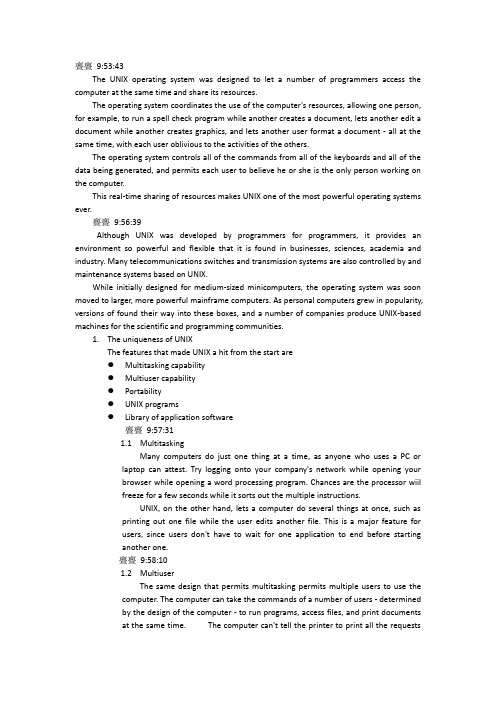
亹亹9:53:43The UNIX operating system was designed to let a number of programmers access the computer at the same time and share its resources.The operating system coordinates the use of the computer's resources, allowing one person, for example, to run a spell check program while another creates a document, lets another edit a document while another creates graphics, and lets another user format a document - all at the same time, with each user oblivious to the activities of the others.The operating system controls all of the commands from all of the keyboards and all of the data being generated, and permits each user to believe he or she is the only person working on the computer.This real-time sharing of resources makes UNIX one of the most powerful operating systems ever.亹亹9:56:39Although UNIX was developed by programmers for programmers, it provides an environment so powerful and flexible that it is found in businesses, sciences, academia and industry. Many telecommunications switches and transmission systems are also controlled by and maintenance systems based on UNIX.While initially designed for medium-sized minicomputers, the operating system was soon moved to larger, more powerful mainframe computers. As personal computers grew in popularity, versions of found their way into these boxes, and a number of companies produce UNIX-based machines for the scientific and programming communities.1.The uniqueness of UNIXThe features that made UNIX a hit from the start are●Multitasking capability●Multiuser capability●Portability●UNIX programs●Library of application software亹亹9:57:311.1MultitaskingMany computers do just one thing at a time, as anyone who uses a PC or laptop can attest. Try logging onto your company's network while opening yourbrowser while opening a word processing program. Chances are the processor wiilfreeze for a few seconds while it sorts out the multiple instructions.UNIX, on the other hand, lets a computer do several things at once, such as printing out one file while the user edits another file. This is a major feature forusers, since users don't have to wait for one application to end before startinganother one.亹亹9:58:101.2MultiuserThe same design that permits multitasking permits multiple users to use the computer. The computer can take the commands of a number of users - determinedby the design of the computer - to run programs, access files, and print documentsat the same time. The computer can't tell the printer to print all the requestsat once, but it does prioritize the requests to keep everything; orderly. It also lets several users access the same document by compartmentalizing the document so that the changes of one user don't override the changes of another user.亹亹9:59:131.3System portabilityA major contribution of the UNIX system was its portability, permitting it tomove from one brand of computer to another with a minimum of code changes. Ata time when different computer lines of the same vendor didn't talk to each other -yet alone machines of multiple vendors - that meant a great savings in both hardware and software upgrades.It also meant that the operating system could be upgraded without having all the customer's data input again. And new versions of UNIX were backward compatible with older versions, making it easier for companies to upgrade in an orderly manner.亹亹10:00:131.4UNIX toolsUNIX comes with hundreds of programs that can be divided into two classes:●Integral utilities that are absolutely necessary for the operation of thecomputer, such as the command interpreter. .●Tools that aren't necessary for the Operation of UNIX but Provide theuser with additional capabilities, such as typesetting capabilities and E-mail1.5UNIX communicationsE-mail is commonplace today, but it has only come into its own in the business community within the last 10 years. Not so with UNIX users. who have been enjoying E-mail for several decades.UNIX E-mail at first permitted users on the same computer to communicate with each other via their terminals. Then users on different machines, even made by different vendors, were connected to support E-mail And finally, UNIX systems around the world were linked into a world wide web decades before the development of today's World Wide Web.1.6Applications librariesUNIX as it is known today didn't just develop overnight. Nor were just a few people responsible far its growth. As soon as it moved from Ball Labs into the universities, every computer programmer worth his or her own salt started developing programs for UNIX, Today there are hundreds of UNIX applications that can be purchased from third-party vendors, in addition to the applications that come with UNIX.亹亹10:03:542.How UNIX is organizedThe UNIX system is functionally organized at three levels:●The kernel, which schedules tasks and manages storage;●The shell, which connects and interprets users' commands, calls programs frommemory, and executes them.The tools and applications that offer additional functionality to the operating system.2.1 The kernelThe heart of the operating system, the kernel controls the hardware and turns part of the system on and off at the programmer's command. If you ask the computer to list (Is) all the files in a directory, the kernel tells the computer to read all the files in that directory from the disk and display them on your screen.亹亹10:06:002.2 The shellThere are several types of shell, most notably the command driven Bourne Shell and the C Shell (no pun intended), and menu-driven shells that make it easier for beginners to use. Whatever shell is used, its purpose remains the same - to act as an interpreter between the user and the computer.The shell also provides the functionality of "pipes", whereby a number of commands can be linked together by a user, permitting the output of one program to become the input to another program.2.3 Tools and applicationsThere are hundreds of tools available to UNIX users, although some have been written by third party vendors for specific applications. Typically, tools are grouped into categories for certain functions, such as word processing, business applications, or programming.。
计算机专业英语Unit04SectionAComputerProgram.ppt
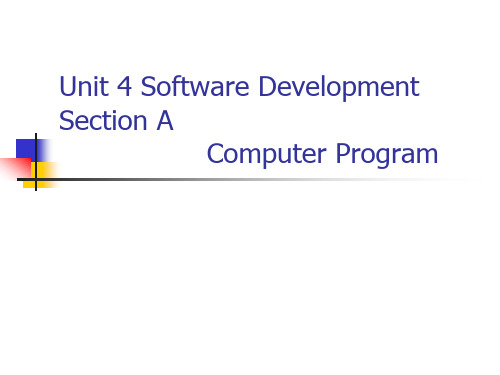
4/56
Computer Program-Introduction
An operating system is a program that manages the computer and the various resources and devices connected to it, such as RAM (random access memory) , hard drives, monitors, keyboards, printers, and modems, so that they may be used by other programs. Examples of operating systems are DOS, Windows 95, OS/2, and UNIX.
I. 引言 计算机程序是指挥计算机执行某种处理功能或功能 组合的一套指令。要使指令得到执行,计算机必须执行程序, 也就是说,计算机要读取程序,然后按准确的顺序实施程序中 编码的步骤,直至程序结束.
2/56
ComБайду номын сангаасuter Program-Introduction
A program can be executed many different times, with each execution yielding a potentially different result depending upon the options and data that the user gives the computer.Yield: vt. 生产,释放,让步
使用M文a本ke编u辑p器: 编,程制序;员弥创补建;一化个文妆本s文he件is,v这e个ry文本文 件是m一u个ch有m序a指d令e 表up,. 也称为程序源文件。构成程序源文 件的M单a个ke指u令p:被化称妆为品源;代码组。成成分,构成方式。
计算机专业英语Unit 4
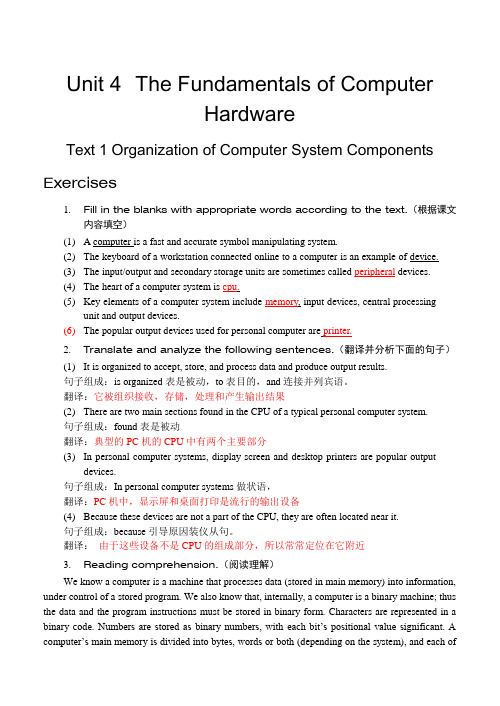
Unit 4 The Fundamentals of ComputerHardwareText 1 O rganization of Computer System Components Exercises1. Fill in the blanks with appropriate words according to the text.(根据课文内容填空)(1)A computer is a fast and accurate symbol manipulating system.(2)The keyboard of a workstation connected online to a computer is an example of device.(3)The input/output and secondary storage units are sometimes called peripheral devices.(4)The heart of a computer system is cpu.(5)Key elements of a computer system include memory, input devices, central processingunit and output devices.(6)The popular output devices used for personal computer are printer.2. Translate and analyze the following sentences.(翻译并分析下面的句子)(1)It is organized to accept, store, and process data and produce output results.句子组成:is organized表是被动,to表目的,and连接并列宾语。
计算机专业英语四Computer English
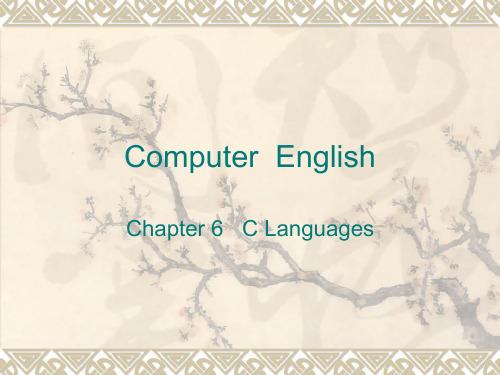
do在此处是助动词,表示强调,意思是“的
确”。还可以是“一定、千万”等意思。如:
Do be careful, please.
Do wait for me at the gate.
Notes
[4] A variable with dynamic duration is created
anew each time the block in which it is declared is
[4] C++ supports the properties of encapsulation and data hiding through the creation of user-defined types, called classes.
译文:C++通过创建称为类的用户定义类型而 支持封装和数据隐藏的属性。 本句中的“through the creation of user-defined types”是状语,而“called classes”是同位语。
宏名称 存储类 运行(时)期系统
source code
global scope
源代码
全局作用域 存储类标识符
storage class specifier
Notes
[1] However, compare to most high-level languages, C
has a very small set of constructs.
一般地说,compare with的意思是“将...与...比较”,强调比较两者
(同类、性质相同)的不同处。compare to的意思是“将...比作...”,
计算机专业英语unit 4-1

website ['websaɪt] 网站
Warming up
domain name [dəuˈmein neim] 域名
Warming up
modem:调制解调器
Warming up
telephone line: 电话线
How can I connect to the Internet?
Listen and act the following dialogue which is about the connection to the Internet.
Unit four Computer network (1)
Contents
1
2
3
Warming up
Real world
Exercises
Warming up
protocol [ ˈproʊtəkɔ:l ] (数据传递的)协议
Warmi] 浏览器
Warming up
Exercises
Task II:
Exercises
Task I. Listen and write down what you’ve heard. 1.I ________________ make an attemptat connecting to the Internet through ADSL. 2.I can’t _____________ the Internet. access modem connects to the 3.You should check whether your ADSL ___________ telephone line in the right way. 4.You should make sure that your telephone line has been activatedfor broadband by your ISP. ________________ username and password for the account. 5.You will need your __________________________ correct information. 6.I have filled in the ___________ configure it in the correct way. 7.You should try to ______________ adapter properties 8.Open properties interface for TCP/IP in your ___________ page. automatically obtain its IP and DNS address. 9.Let the system ________________ 10.I will ________ get down to do that.
- 1、下载文档前请自行甄别文档内容的完整性,平台不提供额外的编辑、内容补充、找答案等附加服务。
- 2、"仅部分预览"的文档,不可在线预览部分如存在完整性等问题,可反馈申请退款(可完整预览的文档不适用该条件!)。
- 3、如文档侵犯您的权益,请联系客服反馈,我们会尽快为您处理(人工客服工作时间:9:00-18:30)。
Chapter 4 Elementary Data Structures
Key points: useful terms and definitions of data structure Difficult points: Stack, queue, tree
Requirements:
我们称对队列进行的插入操作为入队 (ENQUEUE),删除操作为出队 , (DEQUEUE);同栈中的出栈操作一样,出队操作不考虑其中的元素。队列的 ;同栈中的出栈操作一样,出队操作不考虑其中的元素。 先进先出原则就像排队等待注册的一行人群。队列有一个头部和一个尾部。 先进先出原则就像排队等待注册的一行人群。队列有一个头部和一个尾部。当 一个元素入队,它就成为队列的尾部,就像一个新来的学生成为队尾一样; 一个元素入队,它就成为队列的尾部,就像一个新来的学生成为队尾一样;出 队的元素总是队列头部的元素,像是站在队列最前的学生是排队最久的人一样。 队的元素总是队列头部的元素,像是站在队列最前的学生是排队最久的人一样。 (庆幸的是,对于计算机元素,我们不必担心插队的情况。) 庆幸的是, 庆幸的是 对于计算机元素,我们不必担心插队的情况。
Abbreviations:
LIFO(last in first out)后进先出 ( ) FIFO(fisrt in first out)先进先出 ( )
4.1 Stacks and queues
Stacks and queues are dynamic sets in which the element removed from the set by the DELETE operation is prespecified. In a stack, the element deleted from the set is the one most recently inserted: the stack implements a last-in, first-out, or LIFO, policy. Similarly, in a queue, the element deleted is always the one that has been in the set for the longest time: the queue implements a first-in, first out, or FIFO, policy. There are several efficient ways to implement stacks and queues on a computer. In this section we show how to use a simple array to implement each. 栈和队列都是动态的集合, 栈和队列都是动态的集合,其中的元素由预先定义的删除操作可将其去 在栈中,最近被插入的元素最先被删除,即栈是按后进先出(LIFO) 除。在栈中,最近被插入的元素最先被删除,即栈是按后进先出 的原则进行的;类似的,在队列里,被删除的元素是最早进入队列的, 的原则进行的;类似的,在队列里,被删除的元素是最早进入队列的, 即队列是以先进先出(FIFO)的原则进行的。在计算机上,对于栈和队列 的原则进行的。 即队列是以先进先出 的原则进行的 在计算机上, 有几种有效的实现方法,这一节我们给出如何用简单的数组来实现它们。 有几种有效的实现方法,这一节我们给出如何用简单的数组来实现它们。
4.2 Linked lists
Fig.4-3 A doubly linked list
4.2 Linked lists
As shown in Fig.4-3, each element of a doubly linked list L is an object with a key field and two other pointer fields: next and prev. The object may also contain other satellite data. Given an element x in the list, next[x] points to its successor in the linked list, and prev[x] points to its predecessor. If prev[x] = NIL, the element x has no predecessor and is therefore the first element, or head, of the list. If next[x] = NIL, the element x has no successor and is therefore the last element, or tail, of the list. An attribute head[L] points to the first element of the list. If head[L] = NIL, the list is empty. 如图4-3所示,双向链表 中的每个元素都是一个实体 中的每个元素都是一个实体, 如图 所示,双向链表L中的每个元素都是一个实体,由一个数值域和两 所示 个指针域组成,其中两个指针分别是: 个指针域组成,其中两个指针分别是:next和prev,实体也可以包含子数 和 , 给定表中一个元素x, 指出它在链表中的后继, 据。给定表中一个元素 ,next[x]指出它在链表中的后继,prev[x]指出它 指出它在链表中的后继 指出它 的前趋。 表示元素x没有前趋 是第一个元素, 的前趋。prev[x] = NIL表示元素 没有前趋,因此 是第一个元素,即队头 表示元素 没有前趋,因此x是第一个元素 元素;如果next[x] = NIL,表示 没有后继,也就是最后一个元素,队尾 没有后继, 元素;如果 ,表示x没有后继 也就是最后一个元素, 元素。指针head[L]指向队列中的第一个元素,如果 指向队列中的第一个元素, 元素。指针 指向队列中的第一个元素 如果head[L] = NIL表示队 表示队 列为空。 列为空。
4.2 Linked lists
A list may have one of several forms. It may be either singly linked or doubly linked, it may be sorted or not, and it may be circular or not. If a list is singly linked, we omit the prev pointer in each element. If a list is sorted, the linear order of the list corresponds to the linear order of keys stored in elements of the list; the minimum element is the head of the list, and the maximum element is the tail. If the list is unsorted, the elements can appear in any order. 一个链表可以是下面几种形式之一:单向链表或双向链表,有序的或无 一个链表可以是下面几种形之一:单向链表或双向链表, 序的,循环的或非循环的。对于单向链表, 序的,循环的或非循环的。对于单向链表,我们就不必对每个元素使用 prev指针了。如果一个表是有序的,表的线序和表中存储的元素值的线 指针了。 指针了 如果一个表是有序的, 序是一致的, 最小值的元素是队列的头部元素, 序是一致的,即:最小值的元素是队列的头部元素,最大值的元素是队 尾元素。如果一个表是无序的,其中的元素可以以任何顺序出现。 尾元素。如果一个表是无序的,其中的元素可以以任何顺序出现。
4.1 Stacks and queues
4.1.2 Queues We call the INSERT operation on a queue ENQUEUE, and we call the DELETE operation DEQUEUE; like the stack operation POP, DEQUEUE takes no element argument. The FIFO property of a queue causes it to operate like a line of people in the registrar's office. The queue has a head and a tail. When an element is enqueued, it takes its place at the tail of the queue, just as a newly arriving student takes a place at the end of the line. The element dequeued is always the one at the head of the queue, like the student at the head of the line who has waited the longest. (Fortunately, we don't have to worry about computational elements cutting into line.)
4.2 Linked lists
A linked list is a data structure in which the objects are arranged in a linear order. Unlike an array, though, in which the linear order is determined by the array indices, the order in a linked list is determined by a pointer in each object. Linked lists provide a simple, flexible representation for dynamic sets. 链表这个数据结构中的对象都以线性顺序排列的, 链表这个数据结构中的对象都以线性顺序排列的,但不同 于数组的顺序是由数组下标确定, 于数组的顺序是由数组下标确定,链表的顺序是由每个对 象的指针确定。链表为动态集合提供了一个简单、 象的指针确定。链表为动态集合提供了一个简单、灵活的 表示形式。 表示形式。
